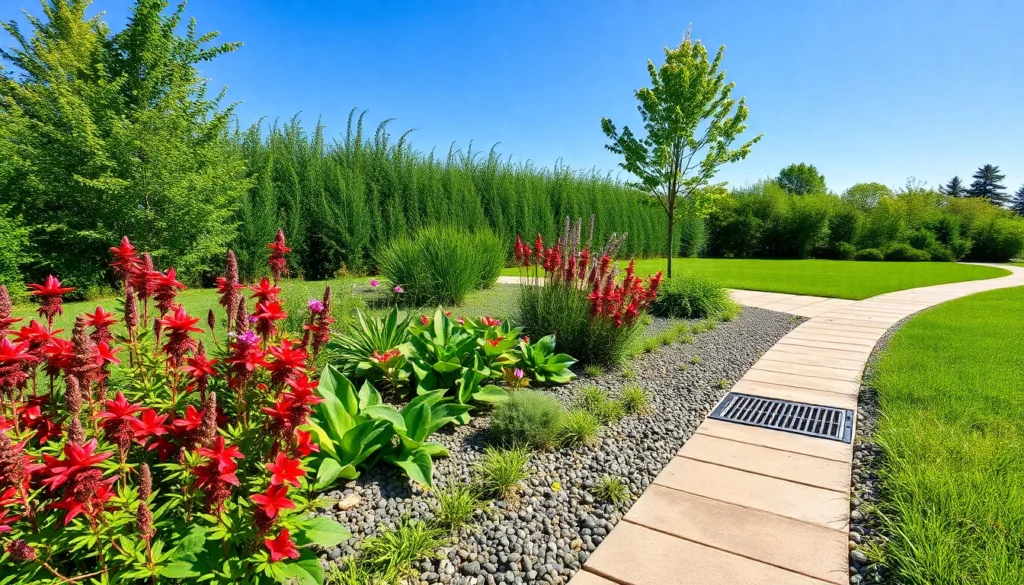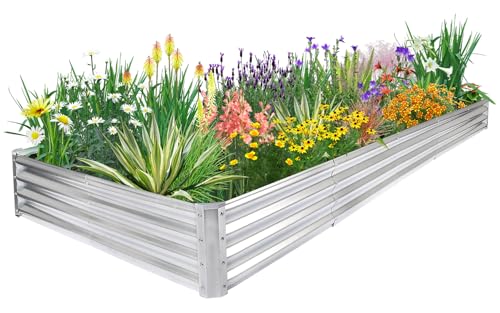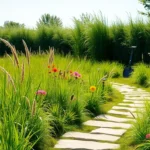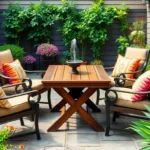Standing water in your garden can quickly turn your green paradise into a soggy nightmare. We’ve all watched helplessly as puddles form after every rainfall while our beloved plants struggle to survive in waterlogged soil. Poor drainage doesn’t just kill plants – it creates breeding grounds for mosquitoes and damages your property’s foundation.
The good news? We don’t have to accept swampy conditions as our gardening fate. With the right drainage answers we can transform even the most problematic wet spots into thriving garden areas. Whether you’re dealing with clay soil that won’t absorb water or low-lying areas that collect runoff effective drainage systems can solve these challenges.
From simple DIY fixes to more comprehensive drainage installations we’ll explore proven methods that actually work. These aren’t just theoretical answers – they’re battle-tested techniques that have saved countless gardens from the perils of poor drainage.
Create a French Drain System for Effective Water Management
French drains offer one of the most reliable long-term answers for managing persistent garden water problems. We’ve seen this underground drainage method successfully redirect excess water away from problem areas while maintaining the natural beauty of outdoor spaces.
Choose the Right Location and Depth
Identify the water source and natural flow patterns before breaking ground on your French drain project. We recommend starting at the highest point where water accumulates and following the natural slope toward your intended drainage outlet. Most residential French drains perform optimally at depths between 18 to 24 inches, though clay soils may require deeper installation up to 36 inches.
Position your drain system at least 6 feet away from building foundations to prevent structural damage. We’ve found that placing drains too close to homes can actually direct water toward basement walls rather than away from them. The drain should terminate at a safe discharge point like a storm drain, dry well, or natural water collection area.
Mark utility lines before digging by calling 811 at least 48 hours in advance. We always verify the locations of gas lines, electrical cables, and water pipes to avoid costly accidents during installation.
Select Appropriate Gravel and Pipe Materials
Choose perforated PVC pipe with a diameter of 4 to 6 inches for most residential applications. We prefer schedule 40 PVC over corrugated plastic pipes because it maintains structural integrity and won’t collapse under soil pressure. The perforations should face downward to prevent sediment from entering the system.
Use washed gravel with sizes ranging from 1/2 inch to 3/4 inch for optimal drainage performance. We avoid using sand or fine gravel as these materials can clog the system over time. River rock and crushed stone work exceptionally well because they create adequate void space for water movement.
Wrap the pipe in industry fabric before installation to prevent soil infiltration while allowing water passage. We recommend using geotextile fabric rather than standard industry cloth because it offers superior filtration properties and longer-lasting performance.
Install Proper Slope for Optimal Flow
Maintain a consistent slope of 1% to 2% along the entire drain length for gravity-fed water movement. We calculate this as a 1 to 2 inch drop for every 100 feet of horizontal distance. Steeper slopes can cause water to flow too quickly and potentially wash away gravel bedding.
Create a level base using a transit level or smartphone leveling app to ensure accurate slope measurements. We dig the trench slightly deeper than needed and add a layer of compacted sand to achieve the precise grade. This foundation prevents pipe settling that could create low spots where water accumulates.
Test the slope by pouring water into the system before backfilling the trench. We verify that water flows smoothly toward the outlet without pooling in any sections. Proper slope installation ensures your French drain system will function effectively for decades with minimal maintenance requirements.
Install Rain Gardens to Capture and Filter Runoff
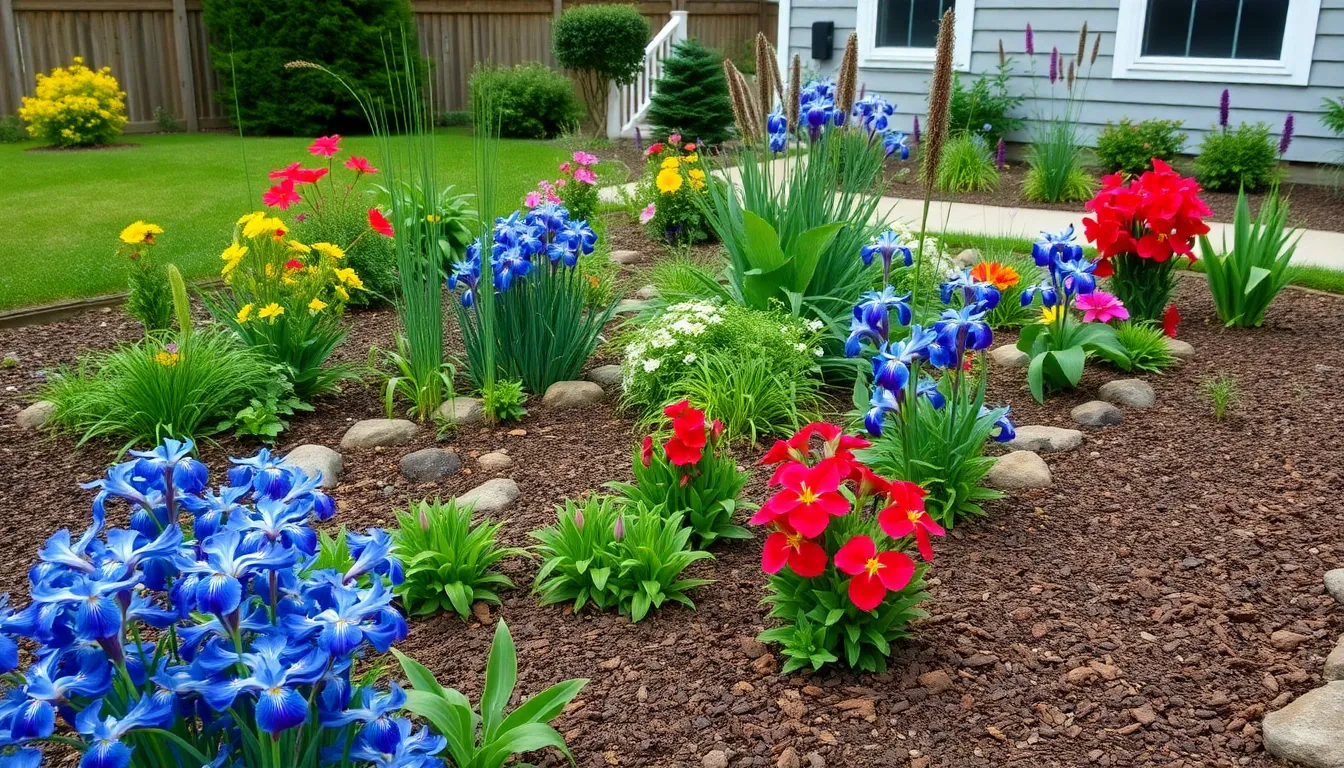
Rain gardens offer an elegant solution for managing drainage challenges while creating beautiful garden features. These shallow depressions work by capturing stormwater runoff from surfaces like roofs and driveways, then slowly filtering the water into the ground.
Select Native Plants That Thrive in Wet Conditions
We recommend choosing native plants with deep root systems that naturally absorb water and filter pollutants from runoff. Native species like cardinal flower, blue flag iris, and swamp milkweed have evolved to handle fluctuating water levels and support local wildlife and pollinators. These plants establish stronger root networks compared to non-native alternatives, creating better water infiltration pathways in your rain garden.
Deep-rooted varieties excel at drawing water down through soil layers, while their extensive root systems help prevent erosion during heavy rainfall events. We suggest mixing plants with different bloom times to maintain year-round visual interest and continuous pollutant filtration capabilities.
Design the Perfect Bowl Shape and Size
Bowl shape design requires careful attention to gradual slopes that allow slow water infiltration rather than rapid drainage. We create shallow depressions with sides that slope gently at a 3:1 ratio, meaning three feet of horizontal distance for every foot of vertical drop.
Size determination depends on your property’s runoff volume and available space, but we typically recommend rain gardens that equal 20% to 30% of the drainage area they’ll serve. Position your rain garden at least 10 feet away from your home’s foundation to prevent water accumulation near the structure.
Depth should range from 6 to 8 inches for most residential applications, allowing proper water ponding without creating stagnant conditions that attract mosquitoes.
Add Mulch and Organic Matter for Better Absorption
Mulch application helps retain moisture between rainfall events while suppressing weeds that could compete with your chosen plants. We apply 2 to 3 inches of organic mulch like shredded leaves or wood chips around plantings, keeping mulch away from plant stems to prevent rot.
Organic matter enhancement through compost addition improves your soil’s water-holding capacity and supports healthy plant growth. We incorporate 2 to 4 inches of compost into the existing soil before planting, creating better soil structure for water absorption and root development.
This combination of mulch and organic amendments creates optimal growing conditions while maximizing your rain garden’s ability to manage stormwater runoff effectively.
Build Raised Garden Beds for Improved Drainage
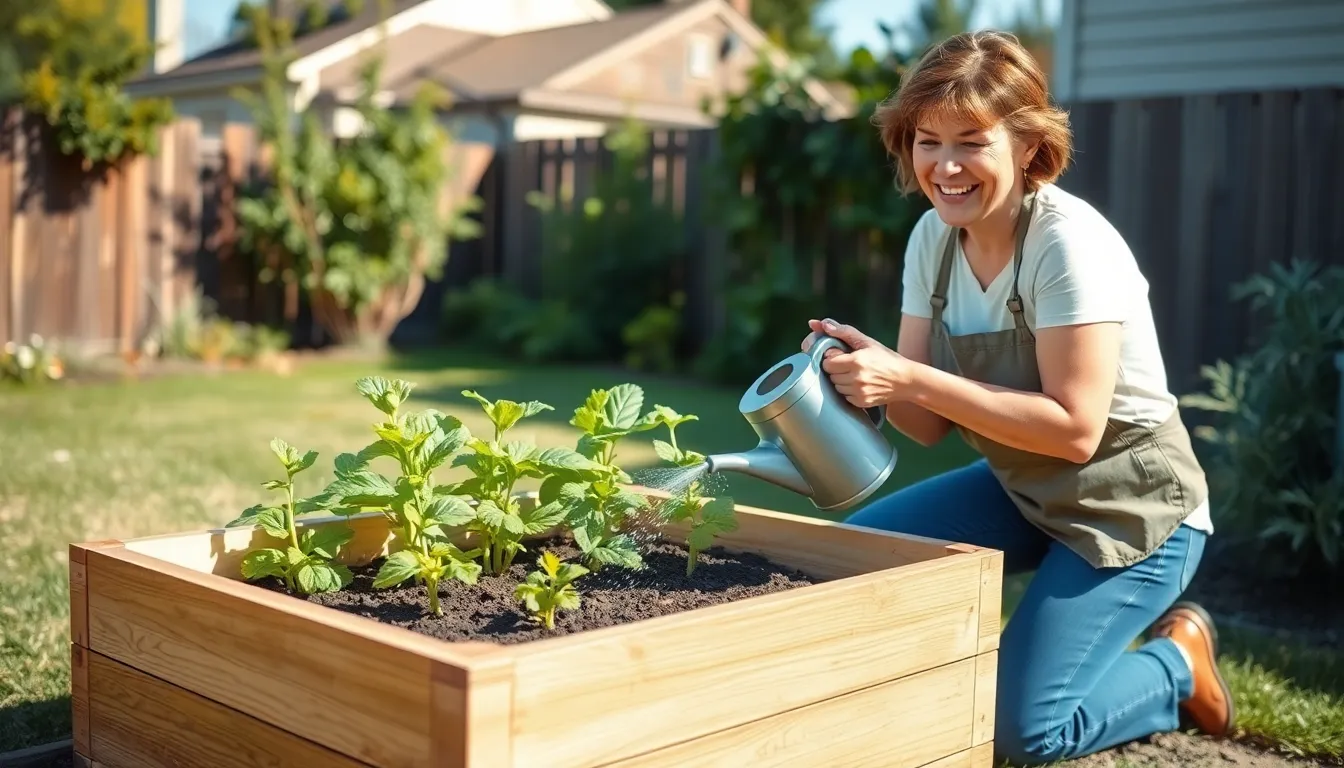
Raised garden beds offer one of the most effective ways to solve drainage problems while giving you complete control over your growing environment. We’ve found that these elevated structures naturally channel excess water downward, preventing the waterlogged conditions that kill plants and create breeding grounds for pests.
Calculate the Ideal Height for Your Soil Type
Determining the right height depends entirely on what’s beneath your raised bed. Clay soils require beds between 12 to 18 inches tall because these dense materials trap water and suffocate plant roots. Sandy or naturally well-draining soils work perfectly with shorter beds of 6 to 12 inches since water already moves through them efficiently.
Taller beds provide better drainage and accommodate deep-rooted vegetables like tomatoes and peppers. We recommend measuring your soil’s drainage by digging a hole and filling it with water—if it takes more than 24 hours to drain, you’ll need the full 18-inch height for optimal results.
Choose Between Wood, Stone, or Metal Materials
Wood remains the most popular choice due to its affordability and simple assembly process. Cedar and redwood naturally resist rot, while treated lumber requires careful selection to avoid chemicals that leach into soil. Stone creates beautiful permanent structures that last decades but demands important labor and higher upfront costs.
Metal options like galvanized steel offer the best of both worlds with excellent durability and superior drainage properties. These materials won’t rot or deteriorate, and their structured design allows water to flow freely through gaps and joints. Corrugated metal panels are particularly effective because they’re lightweight yet strong enough to contain heavy soil loads.
Fill with Well-Draining Soil Mix
Creating the perfect soil blend ensures your raised bed drains efficiently while retaining enough moisture for healthy plant growth. We mix one-third topsoil, one-third compost, and one-third drainage material like sand or perlite to achieve optimal porosity.
| Component | Percentage | Purpose |
|---|---|---|
| Topsoil | 33% | Provides nutrients and structure |
| Compost | 33% | Adds organic matter and water retention |
| Sand/Perlite | 33% | Increases drainage and prevents compaction |
Avoid using your native heavy soil as the primary ingredient, especially if it’s clay-based. This mixture allows water to drain efficiently within hours rather than days, preventing root rot while maintaining the moisture plants need to thrive.
Add Permeable Hardscaping Elements Throughout Your Space
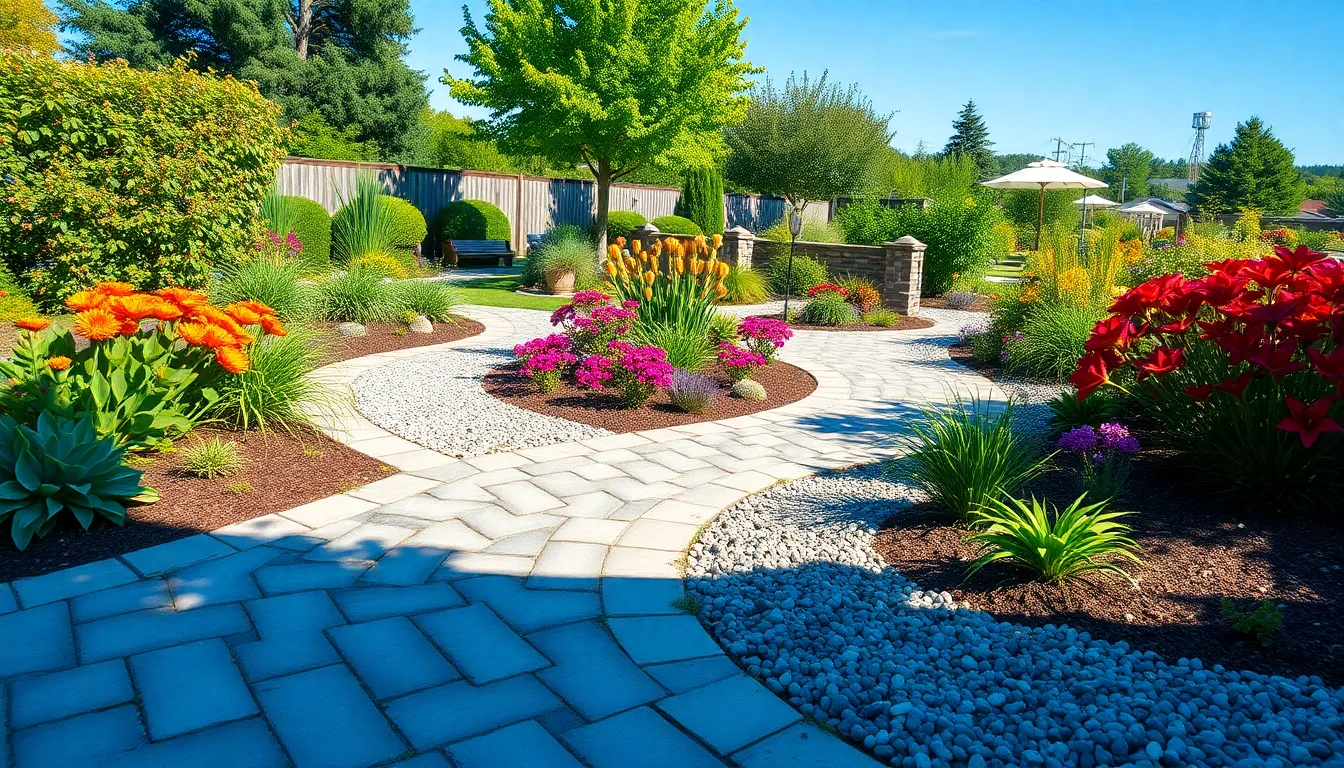
Incorporating permeable hardscaping materials creates natural drainage pathways while maintaining the functional beauty of your garden design. These innovative answers allow rainwater to pass through surfaces instead of creating runoff that can overwhelm your existing drainage systems.
Install Permeable Pavers for Walkways
Permeable pavers transform traditional walkways into effective water management systems that mimic natural drainage processes like topsoil and grass. We recommend installing these specialized pavers to create smooth, accessible surfaces that allow water to seep directly into the soil below. The porous design reduces flooding risks while requiring minimal maintenance compared to solid concrete pathways.
Installing permeable pavers offers important accessibility advantages for individuals with disabilities by providing smoother surfaces than traditional stone or gravel paths. These durable materials withstand various climates without cracking or peeling, making them a long-term investment for your garden infrastructure. Water filters through the gaps between pavers, maintaining soil health and preventing the erosion issues commonly associated with impermeable walkways.
Create Gravel Pathways Between Garden Areas
Gravel pathways provide highly permeable connections between different garden zones while allowing rapid water drainage into surrounding soil. We suggest using washed gravel in various sizes to create attractive, functional pathways that require minimal upkeep once established. The natural porosity of gravel eliminates standing water issues while preventing weed growth when properly installed with industry fabric underneath.
These cost-effective pathways handle heavy foot traffic while maintaining excellent drainage performance throughout wet seasons. Gravel naturally shifts and settles to accommodate water flow, making it an ideal choice for areas with fluctuating moisture levels. The material also helps prevent soil compaction in high-traffic areas between garden beds.
Use Decomposed Granite for Natural-Looking Surfaces
Decomposed granite creates stable, weed-resistant surfaces that filter water naturally while maintaining an organic appearance in your garden design. We recommend this porous material for patios, seating areas, and utility spaces where you need firm footing combined with excellent drainage capabilities. The fine particles compact to form a solid surface while still allowing water penetration to reduce runoff.
This natural material offers superior durability compared to loose gravel while providing better drainage than solid hardscaping options. Decomposed granite requires minimal maintenance once installed and develops an attractive patina over time that complements surrounding vegetation. The material naturally suppresses weed growth while supporting healthy soil conditions through filtered water infiltration.
Incorporate Underground Drainage Tiles and Pipes
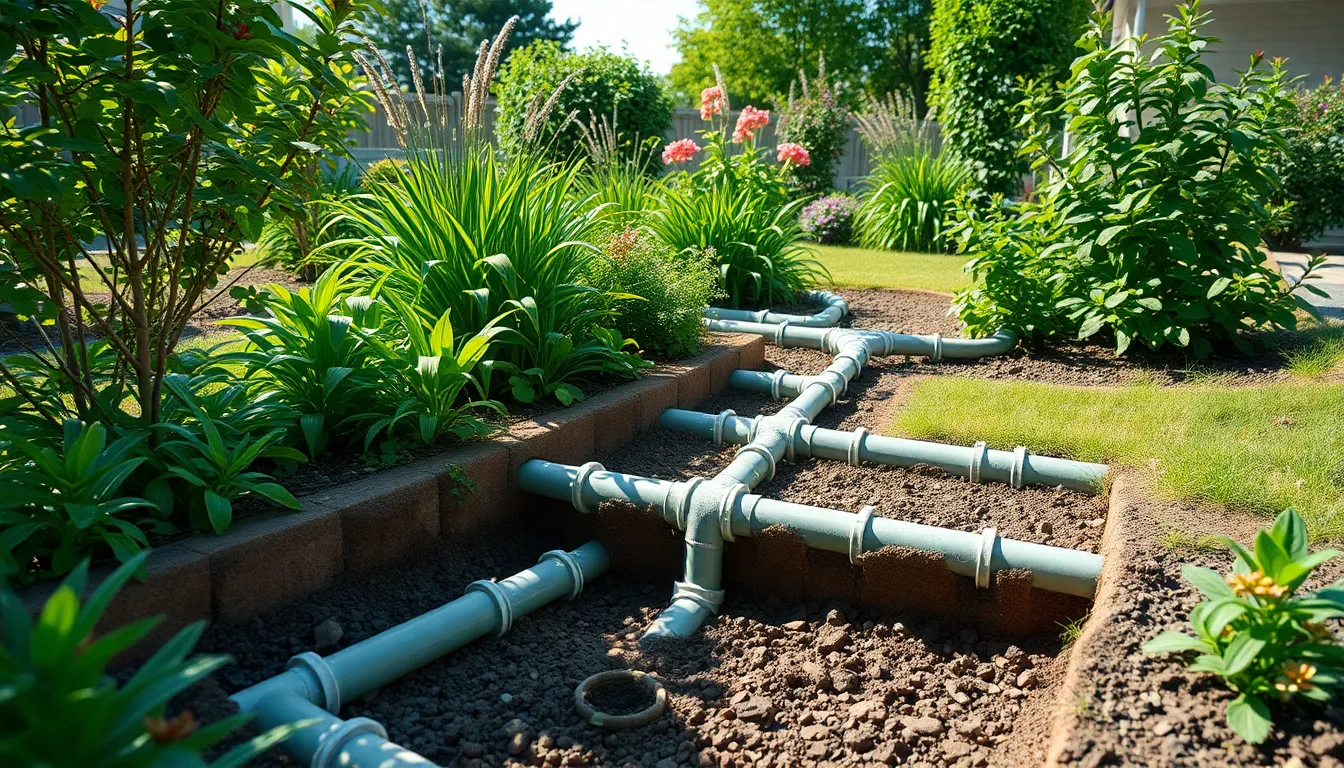
Underground drainage systems offer the most comprehensive solution for persistent water problems in our gardens. These systems work beneath the surface to capture and redirect water before it can pool or damage plants.
Map Out Problem Areas Before Installation
Identifying low spots requires careful observation after heavy rainfall to see where water naturally collects. We should walk through our garden during and immediately after storms to mark these trouble areas with spray paint or flags.
Assessing the natural slope helps us understand how water moves across our property and whether it flows away from our house foundations. We can use a basic transit level or smartphone apps to measure the grade and ensure we’re working with gravity rather than against it.
Testing soil drainage involves digging small test holes about 12 inches deep and filling them with water to see how quickly it absorbs. Clay soils that hold water for more than 24 hours will need deeper drainage answers than sandy soils that drain within a few hours.
Select Perforated vs Solid Pipe Options
Perforated pipes excel at capturing water from the surrounding soil and distributing it throughout French drain systems. These pipes feature small holes that allow water to enter and exit along their entire length, making them perfect for areas where we need to collect standing water.
Solid pipes work best for directing captured water to a exact destination like storm drains or dry wells. We use these when we need to transport water over longer distances without allowing it to seep out along the way.
Pipe diameter typically ranges from 4 to 6 inches for residential gardens, with larger pipes handling greater water volumes but requiring more extensive excavation. Most garden drainage projects succeed with 4-inch perforated PVC pipes wrapped in geotextile fabric to prevent soil infiltration.
Connect to Existing Storm Drains or Dry Wells
Storm drain connections provide the most effective way to remove water from our gardens when municipal systems are available nearby. We must obtain proper permits and follow local codes when tying into existing storm infrastructure.
Dry well installation works perfectly in areas where storm drain access isn’t feasible, allowing water to slowly seep into the surrounding ground. These underground chambers typically measure 3 to 4 feet in diameter and 4 to 6 feet deep, filled with gravel and connected to our drainage pipes.
Combination systems offer maximum flexibility by connecting multiple drainage methods throughout our garden. We can route water from French drains to dry wells and from dry wells to storm drains, creating redundant pathways that prevent system overload during heavy rainfall.
Design Strategic Swales and Berms for Water Direction
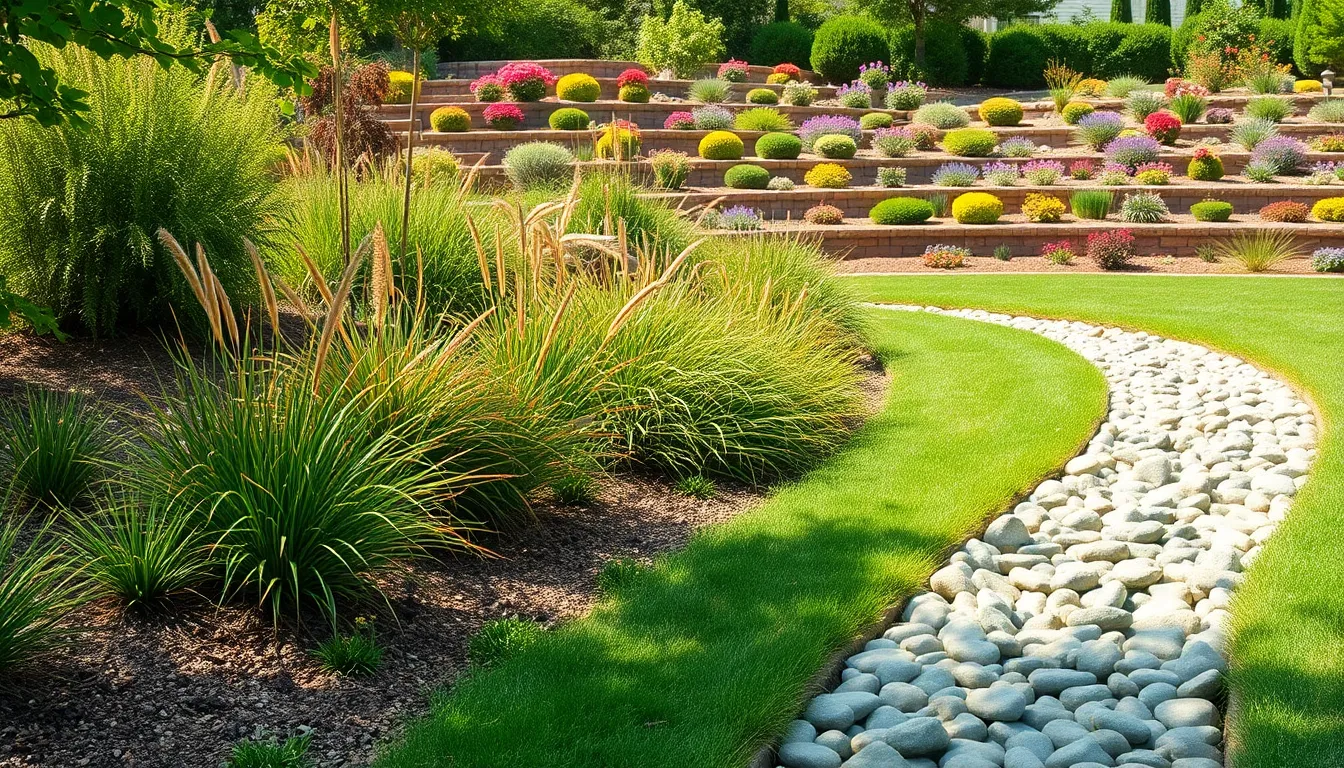
We can transform our garden’s drainage challenges by strategically designing swales and berms that work with natural water flow patterns. These industry features redirect excess water while maintaining the aesthetic appeal of our outdoor spaces.
Create Natural-Looking Industry Features
Swales work as shallow, grass-covered ditches that follow natural slopes to capture and divert water runoff. Built along existing contours, these subtle drainage answers blend seamlessly into our yard’s industry while preventing water accumulation in problem areas. We’ll find that swales remain mostly invisible yet highly effective at managing stormwater.
Dry creek beds offer a decorative approach to water diversion using rocks and carefully selected plants. Stone placement guides water flow toward designated areas while adding visual interest to our garden design. These features combine functionality with beauty, creating natural pathways that handle seasonal water movement.
Garden terraces create stepped elevations that control water runoff down slopes. Each level catches and slows water movement, preventing soil erosion while showcasing different plant varieties. We can build terraces using retaining walls or natural stone to achieve both drainage control and industry drama.
Berms provide raised areas that direct water flow and create garden elevation changes. Strategic placement of these mounded features channels runoff away from sensitive areas while offering opportunities for creative planting designs. Berms work particularly well when combined with swales to create comprehensive water management systems.
Plant with Deep-Rooted Grasses and Shrubs
Rain gardens use native plants with extensive root systems to capture and filter stormwater naturally. Deep roots help retain water within designated areas, preventing flooding in other garden sections while supporting local wildlife habitats. We should select plants that thrive in both wet and dry conditions.
Native grasses establish robust root networks that improve soil stability and water absorption. Species like switchgrass and prairie dropseed create natural filtration systems while requiring minimal maintenance once established. These grasses handle seasonal water fluctuations while providing year round visual appeal.
Shrubs with fibrous root systems enhance drainage capacity around swales and berms. Plants such as elderberry and red twig dogwood tolerate wet conditions while their roots create channels for improved water infiltration. Strategic shrub placement also provides privacy and wildlife habitat benefits.
Maintain Proper Grades for Water Flow
Sloped landscapes require careful grading to direct water away from structures and toward drainage features. We need to ensure consistent slopes of 1% to 2% to maintain adequate water movement without causing erosion problems. Proper grading prevents water accumulation near building foundations.
Terrain adjustments using fill dirt or excavation create effective water flow patterns throughout our garden. Strategic reshaping guides runoff toward swales, rain gardens, or other designated collection areas. We can combine grading with hardscaping materials that allow water penetration while maintaining accessibility.
Regular maintenance of established grades ensures continued drainage effectiveness over time. Settling soil and plant growth can alter water flow patterns, requiring periodic adjustments to maintain optimal performance. We should inspect and refresh drainage grades annually to prevent future water management issues.
Install Catch Basins and Surface Drains in Low Areas
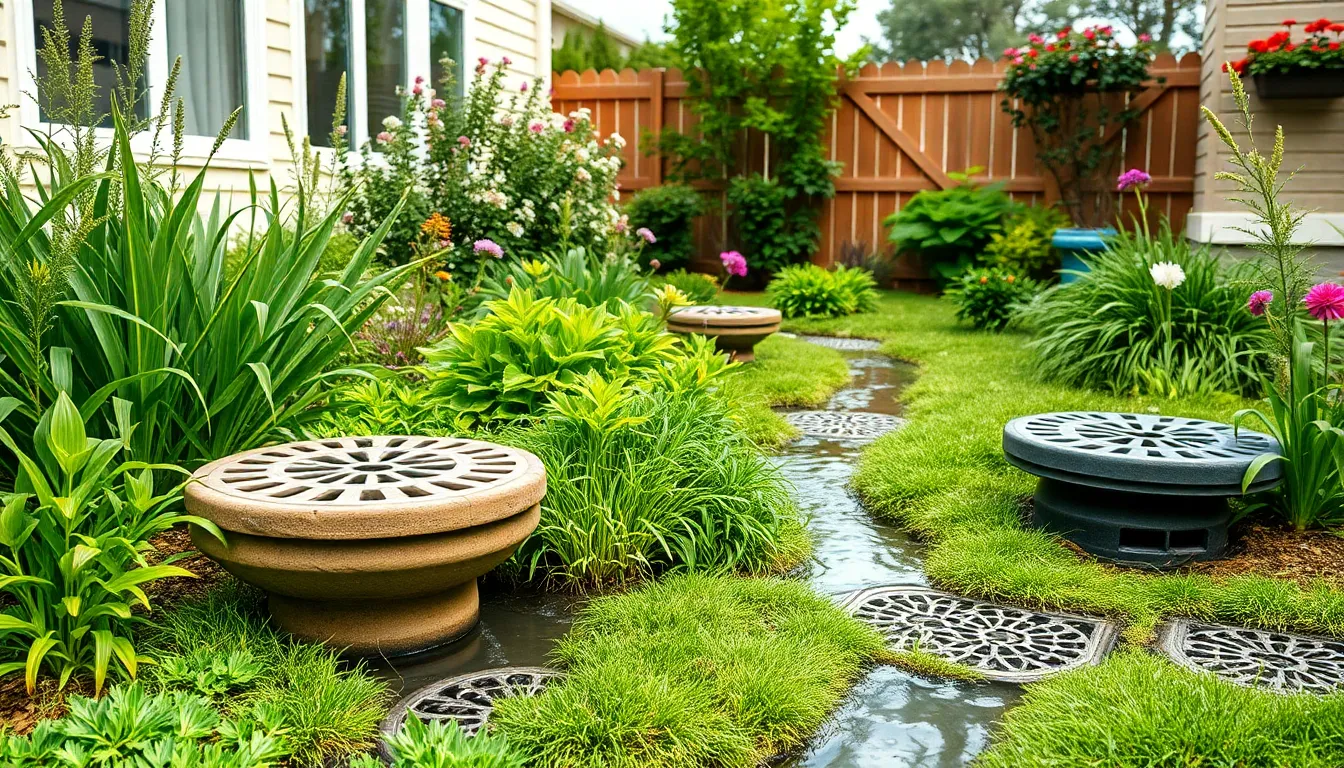
Catch basins and surface drains provide targeted water removal where your garden needs it most. These systems capture standing water before it can damage plants or create mosquito breeding grounds.
Position Drains at the Lowest Points
Identifying natural low spots in your garden creates the foundation for effective drainage placement. We recommend walking your property during heavy rain to observe where water naturally pools and accumulates. Survey stakes help mark these problematic areas for precise drain positioning during dry weather.
Measuring the exact depth of water accumulation guides our drain sizing decisions. Shallow pools under 2 inches require basic surface drains, while deeper standing water needs catch basins with greater capacity. Digital levels ensure accurate slope measurements from surrounding areas toward your chosen drain locations.
Installing drains at true low points maximizes water capture efficiency throughout your drainage system. Multiple small drains often work better than single large units, especially in irregularly shaped garden areas. Testing with a garden hose confirms proper positioning before final installation begins.
Choose Decorative Grates That Match Your Style
Selecting grates that complement your garden’s aesthetic maintains visual appeal while solving drainage problems. Cast iron grates offer traditional elegance and exceptional durability for formal garden settings. Modern polymer options provide lighter weight alternatives with contemporary styling for minimalist landscapes.
Sizing considerations balance functionality with design preferences across different garden zones. Square grates suit geometric garden layouts, while round options soften harsh angles in organic planting schemes. Decorative patterns like leaf motifs or geometric designs add visual interest without compromising water flow capacity.
Color coordination helps drains blend seamlessly into your existing hardscape elements. Bronze finishes complement natural stone pathways, while black options disappear against dark mulch or soil. Custom powder coating allows perfect color matching for exact design requirements.
Connect to Underground Discharge Systems
Underground connections move captured water safely away from your garden to appropriate discharge points. We install solid PVC pipes from catch basins to prevent clogging during water transport to final destinations. Proper pipe sizing ensures adequate flow capacity during heavy rainfall events.
Connecting to existing storm drains requires local permits and professional assessment of municipal system capacity. Street discharge points need proper grading to prevent water backup into your garden drainage network. Dry wells provide excellent alternatives where municipal connections aren’t available or practical.
Maintaining consistent slopes of 1% to 2% ensures reliable water flow through underground discharge systems. Junction boxes allow multiple drain connections while providing access for future maintenance needs. Testing the entire system with water confirms proper flow before backfilling excavated areas.
Amend Heavy Clay Soil with Organic Materials
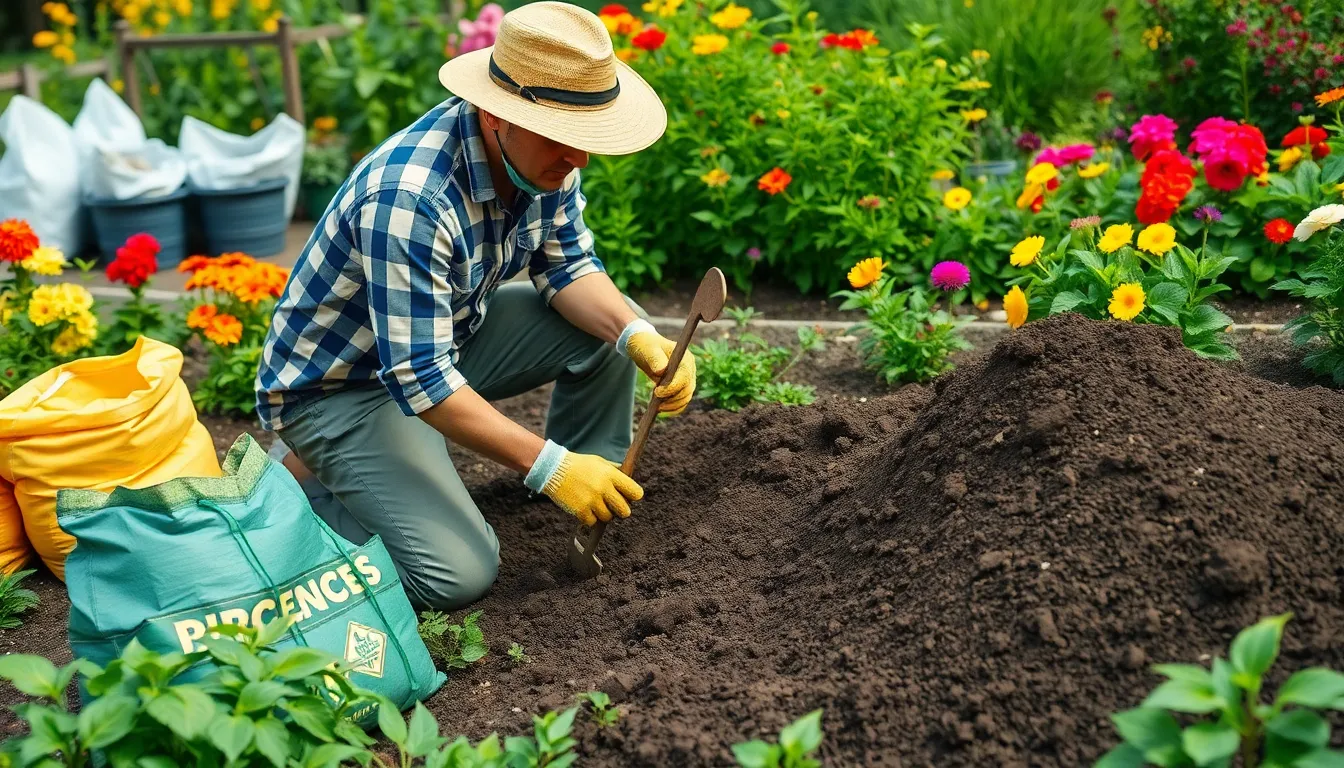
Transforming heavy clay soil requires strategic amendments that break up compacted particles and create drainage pathways. Organic materials naturally improve soil structure by adding beneficial microorganisms and creating air pockets that allow water to flow through more easily.
Add Compost and Aged Manure Regularly
Compost creates a sponge-like structure in clay soil that dramatically improves water penetration and prevents surface runoff. We recommend applying 2 to 4 inches of quality compost to clay areas twice yearly, working it into the top 6 to 8 inches of soil for maximum effectiveness.
Aged manure provides similar benefits while adding essential nutrients that support healthy plant growth in previously waterlogged areas. Chicken manure, cow manure, and horse manure all work exceptionally well when properly aged for at least six months to prevent burning plant roots.
Regular applications build soil structure over time, with most gardeners seeing noticeable drainage improvements within one growing season. We suggest testing different compost sources like leaf mold, mushroom compost, and kitchen scraps to find what works best for your exact soil conditions.
Incorporate Sand and Perlite for Better Structure
Sand addition must be done carefully since the wrong type can actually worsen drainage by creating concrete-like conditions when mixed with clay. Coarse sand or builder’s sand works best, avoiding fine sand that can fill in air spaces and create impermeable layers.
Perlite offers superior drainage enhancement without the risks associated with sand, creating permanent air pockets that won’t compress over time. We recommend mixing 20% to 30% perlite into clay soil for immediate drainage improvements, especially in raised beds and container gardens.
Combined applications of sand and perlite create the most effective drainage enhancement, with perlite providing immediate porosity while coarse sand maintains long-term structural stability. Mix these amendments thoroughly into existing soil rather than layering them to prevent water from pooling at different soil interfaces.
Test Soil Drainage Before and After Improvements
Simple percolation tests reveal exactly how well your soil drains before you invest time and money in amendments. Dig a hole 12 inches deep and 6 inches wide, fill it with water, and measure how quickly the water drains away over 24 hours.
Well-draining soil should absorb water at a rate of 1 to 3 inches per hour, while clay soil often drains slower than 0.5 inches per hour. We recommend conducting these tests in multiple locations since drainage can vary significantly across even small garden areas.
Post-amendment testing confirms whether your improvements are working effectively and helps you adjust your strategy if needed. Repeat the same test 30 to 60 days after adding organic materials to see measurable improvements in drainage rates and determine if additional amendments are necessary.
Create Dry Creek Beds for Seasonal Water Management
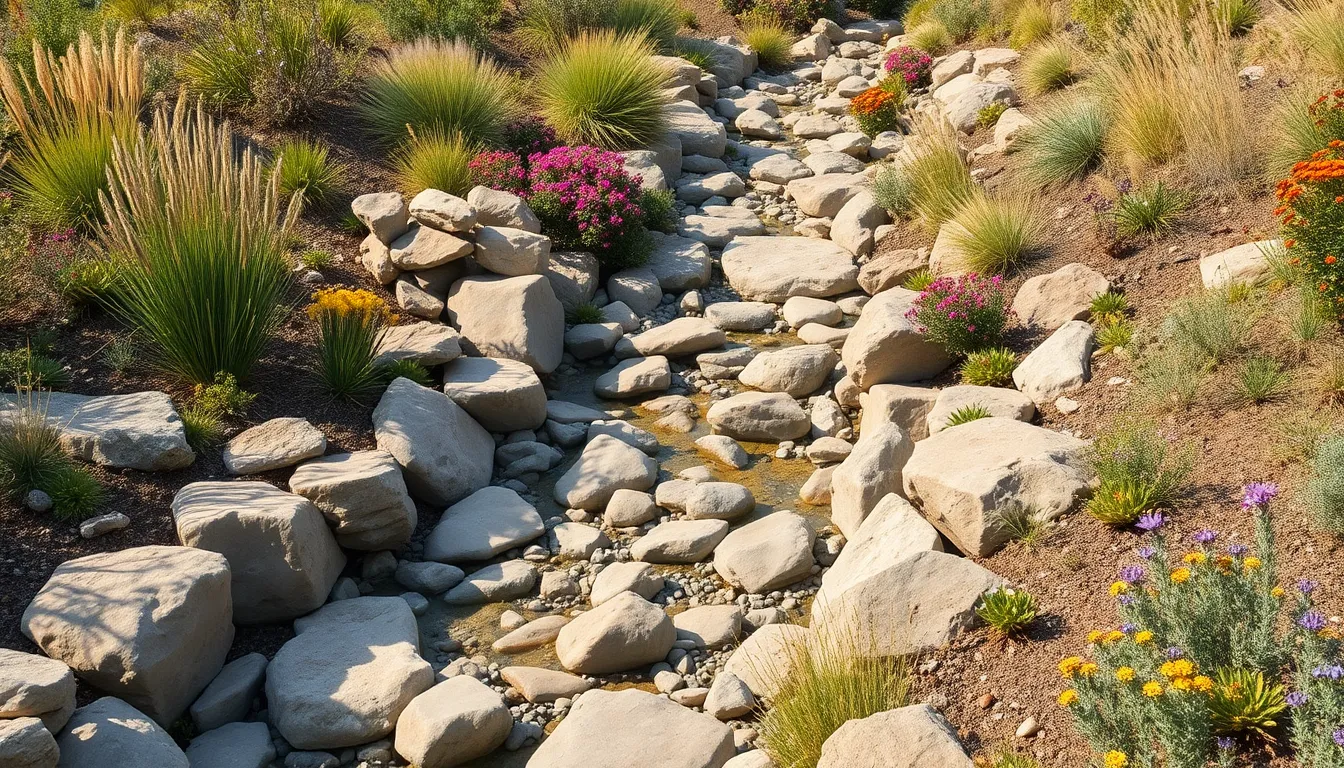
Dry creek beds offer an elegant solution that handles seasonal water flow while transforming problem drainage areas into stunning industry features. These strategic installations direct excess water away from sensitive garden zones during heavy rainfall periods.
Use River Rock and Natural Stone Materials
River rocks provide the ideal foundation for effective dry creek bed construction due to their smooth surfaces that allow water to pass through easily. We recommend layering different sized stones to create natural filtration, starting with larger river rocks at the bottom and gradually transitioning to smaller stones toward the surface.
Natural stone materials enhance both functionality and visual appeal in your drainage design. Smooth river stones prevent erosion while maintaining consistent water flow patterns throughout the creek bed structure. These materials work exceptionally well in decorative swales and French drain applications where long term durability matters most.
Local stone varieties often integrate seamlessly with existing industry elements while providing superior drainage performance. We suggest selecting stones that complement your garden’s color palette and architectural features for maximum aesthetic impact.
Plant Drought-Tolerant Vegetation Along Edges
Drought-tolerant plants thrive in the well-draining conditions that dry creek beds naturally create. Strategic placement of these hardy species along creek bed edges reduces maintenance requirements while supporting healthy soil conditions year round.
Native ornamental grasses like fountain grass and buffalo grass establish quickly in these drainage areas. These plants develop extensive root systems that further improve soil drainage while adding texture and movement to your industry design.
Succulent varieties such as sedum and native wildflowers require minimal irrigation once established. We recommend spacing these plants 18 to 24 inches apart along creek bed margins to allow for natural growth and expansion over time.
Mediterranean herbs including lavender and rosemary add fragrance while tolerating the variable moisture conditions common in seasonal drainage areas. These aromatic plants attract beneficial pollinators during blooming periods while maintaining year round interest.
Design Meandering Paths That Look Natural
Meandering creek bed designs mimic natural water flow patterns while directing excess water efficiently through your garden space. We create gentle curves that follow the natural contours of your industry rather than forcing straight lines that appear artificial.
Natural stone pathways integrated within the creek bed structure provide access for maintenance while improving the overall design aesthetic. These walkways should follow the creek’s natural flow pattern using stepping stones or broader stone sections at strategic crossing points.
Variable width design creates visual interest while accommodating different water flow volumes during seasonal changes. We recommend wider sections at collection points and narrower channels through transitional areas to maintain proper water velocity.
Elevation changes throughout the meandering path help control water speed while preventing erosion in steeper sections. Strategic placement of larger boulders at key points creates natural dams that slow water flow during heavy rainfall events.
Conclusion
Transform your waterlogged garden into a thriving industry with these proven drainage answers. From French drains to rain gardens each method offers unique benefits that address exact water management challenges.
Remember that effective drainage isn’t just about removing excess water—it’s about creating a balanced network where plants flourish and your outdoor space becomes more functional and beautiful.
We’ve equipped you with practical knowledge to tackle any drainage problem. Whether you choose simple amendments or comprehensive systems success comes from understanding your garden’s unique needs and implementing the right combination of techniques.
Start with one method that fits your budget and skill level then expand your drainage network as needed. Your garden will reward you with healthier plants stronger roots and worry-free enjoyment during every season.
Frequently Asked Questions
What are the main problems caused by standing water in gardens?
Standing water in gardens leads to several serious issues including plant root rot and death, mosquito breeding grounds that pose health risks, and potential foundation damage to nearby structures. Poor drainage can also create muddy, unusable garden spaces and promote fungal diseases in plants.
How deep should a French drain be installed?
A French drain should typically be installed 18 to 24 inches deep for most soil conditions. In heavy clay soils, you may need to go deeper, up to 36 inches, to ensure effective drainage. Always position the drain at least 6 feet away from building foundations to prevent structural issues.
What materials are needed for a French drain system?
Essential materials include perforated PVC pipes, washed gravel for backfill, and geotextile fabric to wrap the pipe. The fabric prevents soil from clogging the perforations while allowing water to flow through. Use quality materials to ensure long-term system performance and durability.
What plants work best in rain gardens?
Native plants with deep root systems are ideal for rain gardens. Excellent choices include cardinal flower, swamp milkweed, blue flag iris, and native sedges. These plants thrive in wet conditions, support local wildlife, and help filter stormwater naturally while creating attractive garden features.
How tall should raised garden beds be for drainage?
Raised bed height depends on your soil type. For clay soils with poor drainage, build beds 12 to 18 inches high. Sandy soils that drain well only need beds 6 to 12 inches high. Higher beds provide better drainage but require more soil and materials.
What’s the best soil mix for raised beds with drainage issues?
Create an optimal mix using one-third quality topsoil, one-third compost, and one-third drainage material like coarse sand or perlite. This combination provides nutrients for plants while ensuring excess water drains away quickly, preventing waterlogged conditions that harm plant roots.
How do permeable pavers help with garden drainage?
Permeable pavers allow rainwater to seep through joints and porous surfaces directly into the soil below. This reduces surface runoff, prevents flooding, and helps recharge groundwater naturally. They’re perfect for walkways, patios, and driveways while maintaining accessibility and attractive aesthetics.
What’s the difference between perforated and solid drain pipes?
Perforated pipes collect water from surrounding soil through holes along their length, making them ideal for French drains and subsurface collection. Solid pipes transport collected water from one location to another without additional collection. Most systems use both types strategically.
How do swales and berms work together for drainage?
Swales are shallow depressions that capture and redirect water flow, while berms are raised areas that direct water toward swales. Together, they create a natural water management system that follows landscape contours, preventing erosion while moving water away from problem areas effectively.
Where should catch basins be installed in the garden?
Install catch basins at the lowest points where water naturally accumulates during heavy rain. Observe your garden during storms to identify these spots. Use a digital level to confirm proper grading toward the basin, ensuring water flows efficiently into the drainage system.

